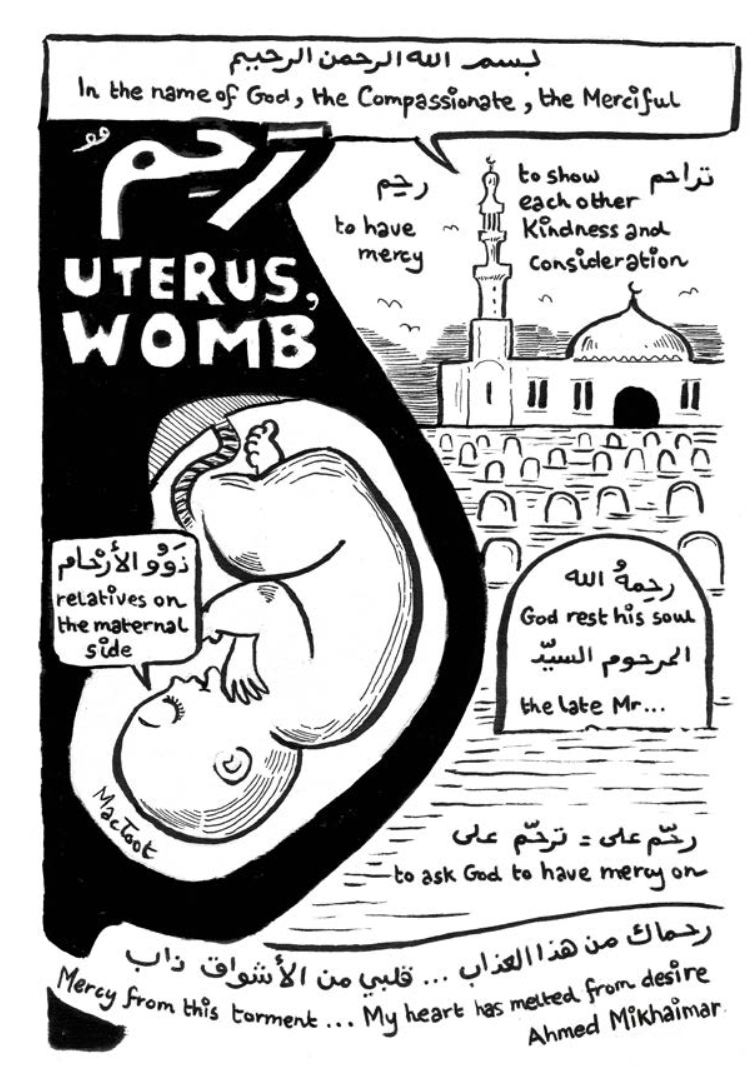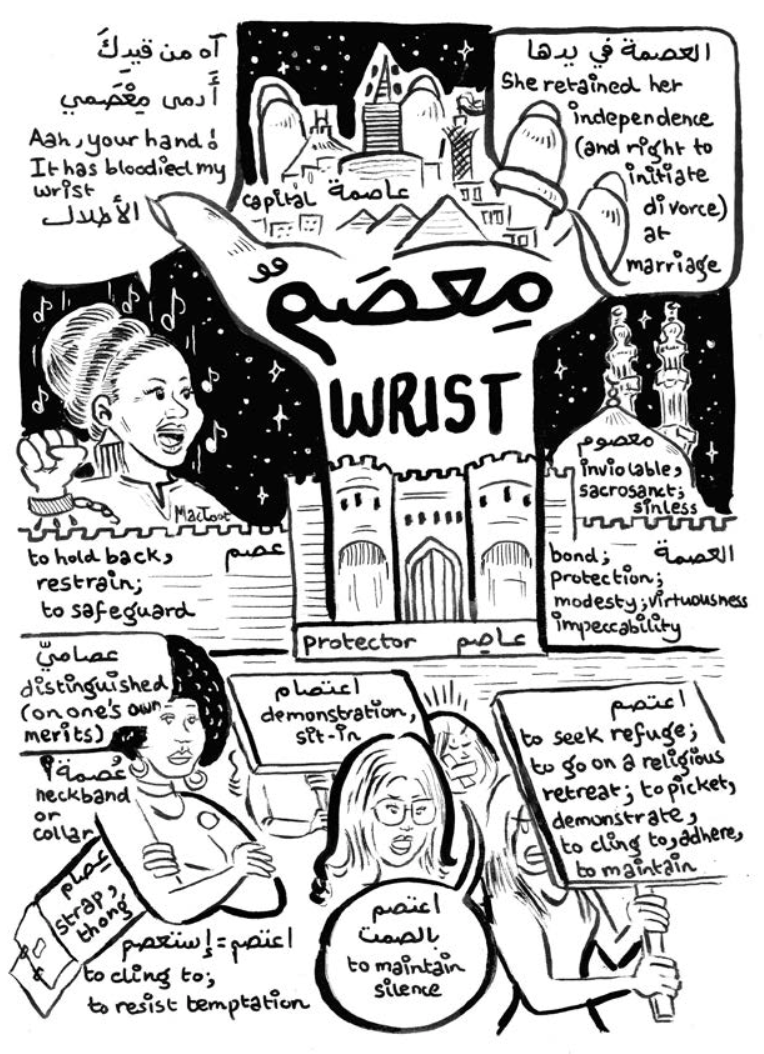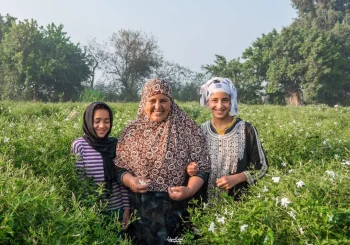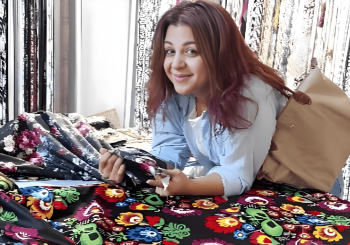An Arabic, illustrated, exploration of all that is and isn’t taboo, Rooted in the Body: Arabic Metaphor and Morphology, a new book coming out by Lisa J. White and Mahmoud Shaltout (MacToot) is a comic-illustrated exploration of the rich vocabulary derived from body parts in Arabic that are often used as metaphors.
White is an American who began studying Arabic in 1975 in her last year at university to satisfy her linguistic curiosity about non-Indo-European languages. Arabic turned out to be so fascinating that, before long, she realized she wanted to make a career of teaching it to adult second language learners like herself, eventually studying Arabic on three continents and in five universities.
Along the way, she has done some literary translations from Arabic to English, including Mohammed Afifi’s Taraniim fii Dhill Tamara, which won the Arabic translation award in 2000.
Arabic morphology later became her primary research interest, and she was looking for new ways to teach it. Between 2005 and 2008, she stumbled on the idea of using body parts and their derivatives to help her post-elementary students navigate Arabic’s root and pattern system. By this she is referring to words such as qadam & mutaqaddim (foot & advanced), rukba & rakiba (knee & to mount/ride) and ‘unuq & i‘tanaqa (neck & to embrace/adopt) .
This became a great way for her to naturally introduce cultural aspects of Arab society and history.
Shaltout, the illustrator of the book, is an assistant professor of Public Health at the American University in Cairo with a PhD in public health. Despite being a science academic, he has been drawing comics from age 7, after having read his first Tintin comic book. He freelanced in art while doing his PhD, and has drawn comics in various publications such as AUC Times, The Caravan, Cairo Gossip, Kohsk comics, and Ophois Comics, most notably his ‘Nuzly and Lubna’ series.
Shaltout was introduced to Lisa in April 2017 through an AUC colleague.

“Lisa had been writing and compiling this material for years to use in her Arabic teaching, and once I met her I was charmed by her knowledge and the subject matter. I felt that as a native Arabic speaker, I was relearning my own language in a more engaging way,” Shaltout tells Egyptian Streets.
The book’s focus on body vocabulary takes an essential part of speech in any language, and teaches it in Arabic in all of its forms, both written and spoken. While these words are often referred to as standard and colloquial, they are, as White says, more accurately a gradation of idioms tailored to different communicative situations.
“Like native speakers, students – and especially those living abroad –need to learn several varieties to make the most of their experience. Introducing body vocabulary is a great way to show them the deep links between formal and informal language,” White tells Egyptian Streets.
An example White brings up is al-’udhn (the ear) which introduces the colloquial phrase ba‘da ’iznak (excuse me), highlighting the connection of the ear to permission, to help students grasp the structural, phonetic, and semantic links between al-’idhn and ista’dhana, which may not be obvious to non-native ears.
“Along the way, one can throw in al-mi’dhana and show how the minaret is actually an instrument pattern-based directly on the ear,” she adds.
As White discovered more and more examples, she started mentioning her findings to native-speaker friends and colleagues and was thrilled that the idea was brand new to them too. She also found that the metaphoric connections between body parts and the vocabulary derived from them also intrigued them, as did its appearance in old texts.
This led her to look for more body derivatives in the Qur’an where she found countless examples. After years of research and discussions with colleagues from comparative literature and history, she knew that such a book had something to offer to all sorts of readers, from near novices to native speakers.
Shaltout then started to work on the book soon after they met in April 2017, and they have now worked on it together for almost three years.
Given the complexity and gradation of this type of information and the different learning styles of students, White knew that presenting these ideas graphically side by side would make them more accessible to readers.

“Any lover of art, cinema, and culture will find many hidden cameos and references,” Shaltout says.
Shaltout adds that the addition of illustrations also makes the book appealing to any visual learner and for comics aficionados and readers who happen to be either Arab or non-Arab.
“During research, I was surprised to learn about how clever Arabic is, in using the form and function of an organ to derive such rich vocabulary. I feel like there definitely was a before and after, especially as a native Arabic Speaker,” he adds
White credits the book Metaphors We Live By by George Lakoff and Mark Johnson, an exploration of the concept of embodiment in English, for helping her develop her research.
“Embodiment, in brief, is the idea that human experience – and therefore human thought – is necessarily tied to the body. Without a body, we die, and so bodies have a hard-wired power over our thinking. Discovering this philosophical premise made everything fall into place for me,” she says.
The metaphoric body in language is not just a feature of Arabic but rather something all humanity shares, she adds, but in Arabic, there’s an added dimension because of the language’s morphological system and longevity.
“Many other researchers have mentioned how a given body part is used in Arabic literature, and a few have spoken of body parts linguistically, in colloquial language and idioms. But none, to my knowledge, have looked at the amplitude of the body in Arabic derivation, from ancient texts right down to the 21st century,” White adds on the book’s uniqueness in Arabic scholarship.
Shaltout adds that this is also the first comic-style educational book to tackle Arabic morphology and embodiment.
“Taking the individual essays and transforming each essay into a single visual was fun and often very challenging. I was fortunate enough to have been given creative control by Lisa. I would first pencil the image and go through them with Lisa, and then pen the final drawing,” he says.

He has included many Egyptian and international cameos in the drawings, including Mohammed Salah, Suad Hosny, Shadia, Umm Kulthum, Anthony Hopkins, Karl Marx, Cher, and many other celebrities.
The book is published by AUC Press, whom Shaltout has been a fan of for many years. “Having collected many of their titles, it was my first suggestion,” he said.
The book comes out in early 2021 and will be available on Amazon (US and UK) and major English language Cairo bookstores including AUC Press.






Comments (0)